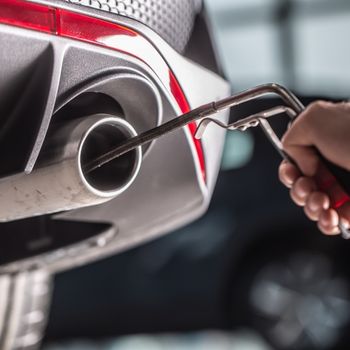How a Defective Exhaust System Can Lead to Carbon Monoxide Poisoning
 Your car's exhaust system plays a crucial role in reducing harmful carbon monoxide levels produced during combustion. If there are issues such as rust-induced leaks or a malfunctioning catalytic converter, this system can fail, allowing dangerous amounts of carbon monoxide to seep into your vehicle's cabin via the ventilation system or other openings.
Your car's exhaust system plays a crucial role in reducing harmful carbon monoxide levels produced during combustion. If there are issues such as rust-induced leaks or a malfunctioning catalytic converter, this system can fail, allowing dangerous amounts of carbon monoxide to seep into your vehicle's cabin via the ventilation system or other openings.
Understanding the potential causes and how to protect yourself is essential for ensuring safety while driving.
How Modern Vehicles Control Carbon Monoxide
The combustion process inside your car generates vast amounts of carbon monoxide—typically over 30,000 parts per million (ppm). To mitigate this risk, vehicles come equipped with a catalytic converter, which converts carbon monoxide into carbon dioxide by mixing it with oxygen. Once this conversion happens in the exhaust manifold, the concentration drops significantly to around 1,000 ppm. Without this vital component functioning correctly, your car could emit levels far exceeding safe limits directly from the tailpipe.
Any defects in the exhaust system—like rusted components or damage to the catalytic converter—can disrupt this mechanism. Consequently, you might unknowingly inhale harmful concentrations of carbon monoxide either through the climate control system or directly into the passenger compartment.
Pathways for Carbon Monoxide Entry
While most people link carbon monoxide poisoning to leaving a running vehicle in an enclosed garage, several other scenarios can lead to its entry into the cabin. For instance, a compromised exhaust system, driving with the trunk or tailgate open, structural damage, or even having the windows down while idling near a source of exhaust can all contribute to exposure.
These problems often stem from underlying issues such as:
Engine Malfunctions
When your engine isn't properly maintained or experiences mechanical failures, it produces excessive carbon monoxide alongside unburned fuel. Such conditions impair the catalytic converter's ability to process these toxins effectively. Insufficient oxygen supply results in elevated carbon monoxide levels escaping through the exhaust pathway.
Rust & Corrosion
Over time, corrosion eats away at critical areas of the exhaust system and bodywork. Neglected rust can create small perforations in vital sections like the exhaust manifold, muffler, catalytic converter, or even joints connecting these elements to the engine block. Water accumulation inside these components during infrequent use accelerates rust formation, leading to initial pinholes that expand over time due to regular vibration and stress during operation.
Open Trunk/Tailgate
Opening the trunk or tailgate might seem harmless enough when airing out the interior or accommodating oversized cargo, but it inadvertently provides an easy path for exhaust fumes to infiltrate the vehicle. The suction effect pulls noxious gases directly toward the backseat area where occupants sit.
Ventilation Systems
Your car’s heating and air conditioning setup draws fresh air from outside and recirculates existing cabin air. Both processes carry the risk of pulling external pollutants—including carbon monoxide—into the interior space where they circulate among passengers.
Detecting Exhaust System Failures
Carbon monoxide itself is odorless, making detection difficult without specific indicators. However, several warning signs should prompt immediate action:
- Unusual Smells: Noticeable exhaust odors inside the cabin suggest a problem with the intake vent or exhaust piping. These smells might resemble burning oil, gasoline, or sulfuric compounds.
- Irritated Eyes: Driving with eyes feeling irritated could signal exposure to toxic fumes.
- Hissing Noises: A distinct hissing sound heard while driving often points to structural weaknesses in the exhaust framework.
- Impaired Functionality: Feeling unusually fatigued, confused, or physically sluggish while operating the vehicle indicates possible CO poisoning.
- Physical Symptoms: Other telltale symptoms include persistent nausea, dizziness, shortness of breath, severe headaches, and chest discomfort—all classic signs of acute carbon monoxide intoxication.
Even brief exposure to high concentrations of CO can induce long-term cognitive impairments. In such cases, evacuate everyone onboard immediately and seek urgent medical care without delay.
Maintaining Safety Against Exhaust Problems
To minimize risks associated with exhaust leaks and subsequent carbon monoxide threats, schedule annual inspections focusing on rust prevention and securing all interconnections throughout the entire exhaust assembly. Additionally:
- Avoid parking the vehicle in confined spaces while idling.
- Never sleep inside a stationary car with the engine running.
- Ensure the tailpipe remains clear of obstructions like snowdrifts or mud piles before starting the engine.
- Regularly inspect floors, side panels, and trunks for signs of structural breaches.
If you suspect existing damage or suspect recent incidents may have compromised your exhaust integrity, contact DaSilva’s Auto Body promptly to arrange comprehensive diagnostics. Our Naugatuck location stands ready to assist with expert assessments tailored specifically for your needs. Don’t wait until it’s too late—your family’s wellbeing depends on proactive maintenance today!
A filter is a common industrial device used to remove impurities and contaminants from liquids or gases. Different types of filters can use different filter media, such as filter bags, filter cartridges, filter membranes and activated carbon. The design and material selection of the filter depends on its application scenario and the type of impurities to be dealt with. Common filter equipment includes filter bag filter, Filter Cartridge filter, magnetic filter, self-cleaning filter and so on. In addition, the filter can also be integrated into filter containers, filter trucks, centrifuges, filter brackets and other equipment to meet different industrial needs.
Cartridge Filter Housing, Bag Filter Housing, Steam Filter Housing,Vessel Filter Cart Skid,
Xinxiang Zhike Machinery Equipment Co.Ltd , https://www.zhikefilter.com